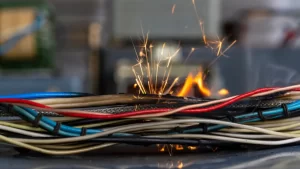What Is a GFCI Outlet?
A GFCI outlet (Ground Fault Circuit Interrupter) is a safety device that monitors the flow of electrical current in a circuit. If it detects even a small difference in the current, it shuts off power instantly to prevent shocks or electrocution.
You can spot one easily by the “Test” and “Reset” buttons on the front. These outlets are required by modern electrical codes in specific areas of the home, but they can also be installed in other locations for extra safety.
At NWA C&S Electric, we often install GFCI outlets for homeowners who want added protection throughout their property, not just in the required spaces.
Can You Put a GFCI Outlet Anywhere?
Technically, yes. A GFCI outlet can be installed anywhere a standard outlet is used. However, it’s most beneficial in areas where water, moisture, or grounding issues could create shock hazards.
For example, adding GFCIs to living rooms or bedrooms won’t hurt, but it’s not always necessary unless those outlets are near windows, radiators, or other moisture sources.
The key is knowing where they’re required and where they offer the most value for safety.
Where GFCI Outlets Are Required by Code
Building codes set specific requirements for where GFCI outlets must be installed. These areas include:
- Bathrooms – Any outlet near a sink or bathtub must have GFCI protection.
- Kitchens – Outlets within six feet of a sink or countertop need GFCI protection.
- Garages – Because garages often have damp floors or power tools, every outlet must be GFCI-protected.
- Laundry Areas – Outlets near washing machines or utility sinks need GFCIs.
- Basements and Crawl Spaces – These areas can have moisture or flooding, making GFCIs essential.
- Outdoor Areas – All exterior outlets must have GFCI protection, including patios, decks, and pool areas.
If your home is older and lacks these safety features, it’s a good idea to upgrade. Doing so not only improves safety but also brings your home up to modern code standards.
When You Might Want GFCI Protection in Other Areas
Even though GFCIs aren’t required everywhere, you can still install them in areas like:
- Living Rooms and Bedrooms: If these rooms have outlets near windows or air conditioning units, GFCIs add extra protection.
- Hallways and Entryways: Outlets near doors where rain might blow in benefit from GFCI protection.
- Workshops and Sheds: These spaces often have tools, moisture, or exposed wiring that increase electrical risks.
Adding extra GFCI outlets is an affordable way to boost your home’s safety without major rewiring.
Can You Replace Any Outlet With a GFCI?
Yes, most standard outlets can be replaced with GFCI outlets, but installation must be done correctly. GFCIs have specific wiring requirements that include “line” and “load” connections. If they’re wired incorrectly, they won’t provide the protection they’re supposed to.
At NWA C&S Electric, our licensed electricians make sure your GFCI outlets are wired correctly, tested, and labeled for proper use. We also ensure they’re compatible with the rest of your electrical system and meet NEC safety standards.
What Happens If You Install a GFCI in the Wrong Place?
There’s technically no “wrong” place to install one, but some locations may not benefit much from having one. For instance, a GFCI installed on a circuit with sensitive equipment (like a freezer or sump pump) could cause unnecessary trips and power loss if the circuit detects small fluctuations.
In those cases, a dedicated circuit or GFCI breaker might be a better option. That’s why it’s best to consult a professional electrician before making major changes.
Why You Should Have a Professional Install GFCI Outlets
GFCI outlets are simple in appearance but complex in function. Installing them incorrectly can cause nuisance tripping or, worse, create a false sense of safety if they’re not wired right.
Professional electricians have the experience to install GFCIs safely and ensure they work as intended. At NWA C&S Electric, we test every installation thoroughly and confirm that your entire circuit is protected, not just one outlet.
Benefits of GFCI Outlets
GFCI outlets do more than meet code—they offer peace of mind. Here are some of the top benefits:
- Protection Against Electrical Shock: Cuts power instantly if there’s a problem.
- Fire Prevention: Stops dangerous arcs that can lead to overheating and fire.
- Code Compliance: Keeps your home up to modern electrical standards.
- Safety for Families: Essential in homes with children or pets.
- Peace of Mind: Prevents accidents in areas where electricity and water mix.
Even if you only upgrade a few key outlets, the added safety is well worth it.
Testing and Maintaining GFCI Outlets
Like any safety device, GFCI outlets need to be tested regularly. You can test them once a month by pressing the “Test” button to cut power, then pressing “Reset” to restore it.
If your outlet doesn’t respond, it may need to be replaced. Most GFCIs last around 10 years but can wear out faster in damp or high-use areas.
Conclusion
So, can you put a GFCI outlet anywhere? The answer is yes, but it’s most important in areas where water and electricity could come together. Bathrooms, kitchens, garages, laundry rooms, basements, and outdoor spaces should always have GFCI protection.
If your home doesn’t have GFCIs in these areas, or if you’re unsure about your current wiring, contact NWA C&S Electric today. Our licensed electricians can inspect your outlets, replace outdated ones, and make sure your home meets safety codes.
Your family’s safety is too important to leave to chance. Let NWA C&S Electric keep your home protected with professional GFCI installation and electrical inspections across Northwest Arkansas.



